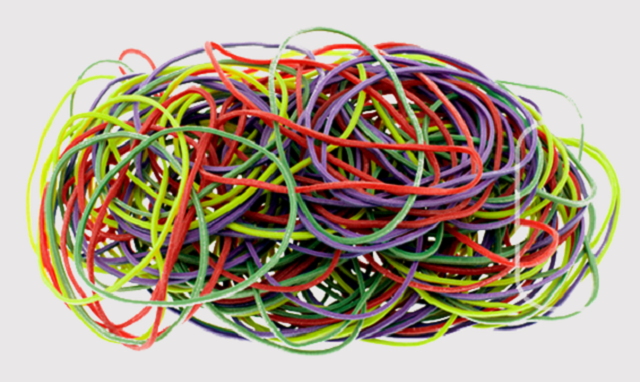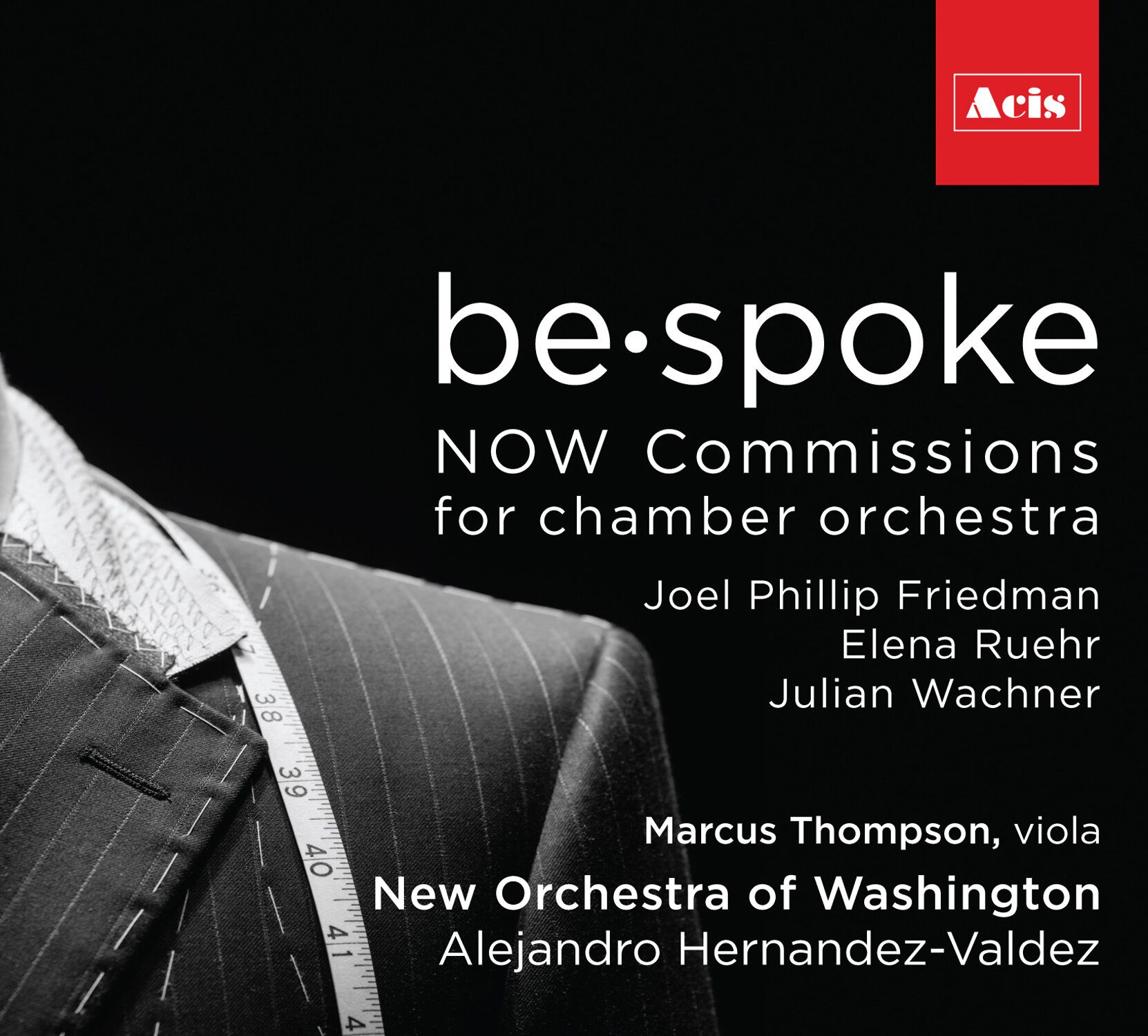Elastic Band (for septet)
Instrumentation
clarinet, string quintet, percussion
Elastic Band is an edgy, playful work that fuses jazz, rock, funk, and classical idioms. It was conceived as a fun, divertimento-like work. The title refers to both the elastic nature of the work–which happily straddles the Classical, 21st Century, and Pop music worlds–and to a pun: the ensemble writing is often more reminiscent of a jazz “little big band” than a traditional chamber ensemble. The original sextet scoring (clarinet and string quartet) has classical resonances. But, add percussion to the mix, and a decidedly jazzy-rock tinge emerges: the Mozart Clarinet Quintet… with a twist, if you will.
A brief and accurate history of all things Elastic as it relates to Band
Elastic Band is an edgy, playful work that fuses jazz, rock, funk, and classical idioms. It has proven to be extremely popular, so I now offer it in "different flavors." Therein lies the confusion. The original Sextet (1996, clarinet, string quartet, and percussion) was cast in four movements. Versions 2-4 are in a more succinct three movements. Next came the Chamber Orchestra revision (2015 clarinet, strings, and 2 percussion) commissioned by Grace Cho and Alejandro Hernandez-Valdez of the New Orchestra of Washington. I knew it would make a great chamber orchestra piece: more bass, more color, and more percussion. But, as chamber ensembles requested Elastic Band, I wanted to keep the piece’s new fullness and concision, so I started my reduction from the chamber orchestra version. The first reduction was a Septet (2017, clarinet, string quintet, and percussion, gotta have that bass!), scored for Evan Solomon and Inscape Chamber Orchestra, and then Jonathan Newman and Timothy J. Robblee at Shenandoah Conservatory asked for an Octet edition (2018, clarinet, string quintet, and 2 percussion, a more exacting reduction of the chamber orchestra version) for the Edge Ensemble. In 2017 the Acis label releases the New Orchestra of Washington’s chamber orchestra recording (available on CD at iTunes and Amazon). This is the version you are more likely to hear. Finally, in 2018 I was asked Leo Sushansky’s National Chamber Ensemble to make a Trio version (clarinet, piano, and percussion) for Julian Miklis of the middle movement, “Pure Happenchance.” By my count that’s 4.33 versions so far. While vastly different, the trio works so well that I’d consider scoring the whole piece for that ensemble. Version 5? Any takers? Contact me.
In conclusion: make sure you look for the version of Elastic Band that fits your needs.
Movements
- Rise
- Pure Happenchance
- Stretch: Snap Back!
You can listen to the chamber orchestra version here:
Program Note
Elastic Band
Program Note by the Composer
(NB: these notes are free for use but cannot be altered/edited without the permission of the composer)
Elastic Band for chamber septet is scored for clarinet, string quintet, and percussionists.
I. Rise; II. Pure Happenchance; III. Stretch: Snap Back!
Elastic Band was conceived as a fun, divertimento-like work. The title refers to both the elastic nature of the work–which happily straddles the Classical, 21st Century, and Pop music worlds–and to a pun: the ensemble writing is often more reminiscent of a jazz “little big band” than a traditional chamber ensemble. The original scoring for clarinet and string quartet has classical resonances. But, add percussion to the mix, and a decidedly jazzy-rock tinge emerges: the Mozart Clarinet Quintet… with a twist, if you will. Additional strings, plus a second percussionist add texture, color, and impact.
I wanted all three music worlds to co-exist and co-mingle within the piece. Among the Classical elements are: the clarity and symmetry of phrases, and the three-movement design (a more serious-toned opening movement in sonata form; a quirky “Ellingtonian” scherzo second movement; and, finally, a lighthearted rondo-like finale). However, the free chromatic writing, quick tempo shifts, and irregular meters and rhythms are most definitely contemporary concert music! That said, much of the work’s detail–the rhythmic, harmonic, and gestural language–comes from jazz, or its cousin–funk-fusion music.
Growing up playing jazz, rock, and classical I was always struck by how the harmonic and rhythmic materials found in some 20th Century music, e.g. Stravinsky and Bartók, resembled the sound worlds of jazz and funk. Elastic Band is steeped in that favorite scale of the 20th Century: the eight-note octatonic scale (an alternating pattern of whole and half steps, referred to as the “symmetric diminished” scale in jazz). By selecting only parts of the scale I could make a “filter.” “Tightening” the filter created familiar, “tonal” jazz harmonies. “Opening” the filter, using more of the scale, allowed for denser, more chromatic sounds. But, probably the most striking, and popular, element in both Stravinsky and Bartok’s music was their fantastic sense of rhythm. Like jazz and funk, their music has “beat.” It heavily employs rhythmic syncopation, but against that clear and strong, if sometimes changing, pulse–a trait common in my music as well.
Rise, the first movement of Elastic Band, is cast in a tight sonata form that is a “hat tip” to the Classical Style, and is a good example of the previously mentioned “filtering effect.” The tenser, more chromatic opening theme is opposed by the more expansive and tonal-sounding second theme. Motivically the movement is very organic: almost everything heard is thematically related to either the clarinet’s opening melodic idea–a falling perfect 4th followed by a rising major 2nd–or the brief, seemingly “improvisatory” rock-style drum breaks that periodically explode during the movement (listen to how they later reappear in the pitched instruments!). For you musical detectives in the audience: these drum breaks echo a figure used by Ringo Starr in his only commercially recorded Beatles drum solo (here’s a hint: it’s on Abbey Road). At the center of the movement is a brief moment of repose–the eye of the storm–that also marks the beginning of a terse, unstable, and dramatic development section that gradually re-gathers momentum and drives towards the recapitulation the opening themes. The movement ends with a scampering perpetual motion coda.
The second movement, Pure Happenchance, functions like a quirky scherzo–the dance movement!–with Duke Ellington overtones in the primal drum ostinato and the clarinet’s timbre (think of Ellington’s 1920’s “jungle music”) … and even a hint of klezmer. This movement relies more on juxtaposition and pop-like repetition than the classical-style motivic development found in the outer movements. The scoring is reminiscent of jazz big band writing (e.g. sectional voicings, or harmonizations, of a line in the strings) and the percussion replete with the ostinatopattern.
The third movement, Stretch: Snap Back!, while often the most overtly “jazz-funk,” also harkens back to the Classical model of the finale: a fun rondo-like romp. The rondo is characterized by a returning refrain. But, here the repeats are developed and rarely literal. While the opening rondo musical material might be reminiscent of Earth, Wind, & Fire meets the Brecker Brothers, the irregular meters, sudden temporal shifts, and developmental process are fully contemporary concert music. Ideas from the first movement freely float in and out of the finale. The rondo idea, and the subsequent second theme, are characterized by funky, syncopated rhythms. In contrast, the central section, signaled by the first abrupt tempo change, is lyrical and broad (but over a “chugged” accompaniment). Like the 1st movement there is an unstable, “free-for-all” development section in the middle (that begins as the recap of the opening rondo). Later on a swaggering blues treatment of the second theme appears, only to be cut short by a compact, breathless coda.
Elastic Band has had a rather long and circuitous journey. The piece began as a chamber sextet (clarinet, string quartet, and one percussionist), and while it has had a healthy life in this version (including performances by Speculum Musicae, the New York Chamber and Adorno Ensembles), I always felt that it would make a great chamber orchestra piece. Grace Cho and Alejandro Hernandez-Valdez of the New Orchestra of Washington graciously commissioned me to revise and rescore the work for clarinet, fuller strings, and two percussionists playing a larger battery of instruments. Most recently, at the request of Evan Solomon of the Inscape Chamber Orchestra, I have created a chamber septet edition: clarinet, string quintet, and 1percussion. It’s all about that bass. I do prefer this edition to the original sextet version.
Perusal score
Reviews
“An added bonus was a performance of composer Joel Phillip Friedman’s “Elastic Band,” a work of serious fun, which also draws on pop and jazz… [Friedman] has ingeniously transformed popular themes in a chamber setting. He even cops (his admission) Ringo Starr’s famous, thudding drum solo from the Beatles’ “Abbey Road” and turns it into a motif. The second movement takes on Duke Ellington’s “jungle music” of the ’20s when the great Sonny Greer sat behind the traps.” Richard Scheinin, The Mercury News
“The final work in the programme is Joel Phillip Friedman’s Elastic Band. Here we move into the worlds of Rock and Jazz which lends the music a ‘drum break’ and Big Band mélange, served up with great confidence by the composer. Friedman explicitly cites Barney Bigard’s clarinet playing and Duke Ellington’s ‘Jungle’ music when discussing the second movement, Pure Happenchance, and in the clarinet/drum exchanges, the jazz ensemble sound, feel to rhythm and in its sectional approach this makes sense. The shifting meters in the finale are part of a full-on, sonically wild Rondo, complete with enticing jazzy lope from the clarinet – Jeremy Eig should be mentioned here for his fine playing – and a slightly sleazy air to the proceedings. This is certainly the most demotic and outgoing of the three pieces.” Jonathan Woolf, MusicWeb International
Watch: A fun seven-minute film created by director Francisco Campos-Lopez during the lead up to the 2015 world premiere of the chamber orchestra version of Elastic Band with the New Orchestra of Washington. Beautiful work by Franco. The film describes a bit about me, my work process, and the piece itself. Check it out!

